Plow Pose Guide: How Halasana Transforms Your Body And Mind
Immerse yourself in the transformative power of Plow Pose. This full-body stretch, known as Halasana, brings rejuvenation and wellness to your daily routine.
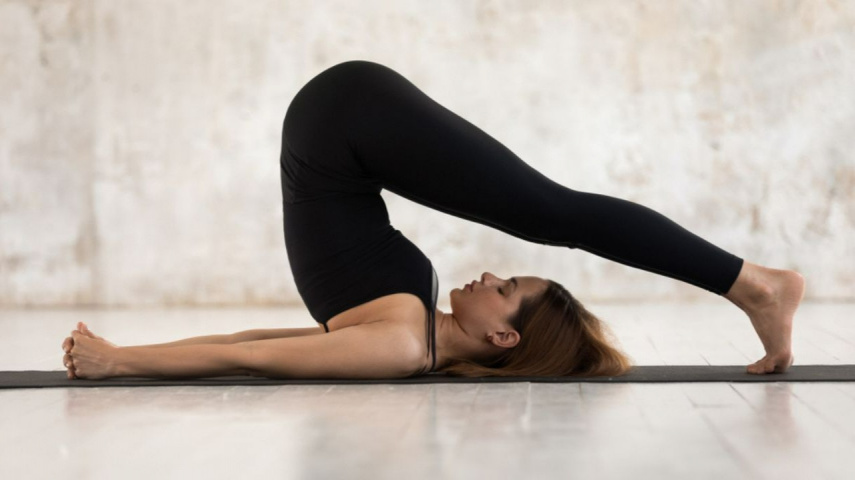
Starting your fitness journey through yoga is exciting. You will come across a whole lot of amazing yoga poses. Plow Pose, known as Halasana in Sanskrit, is one of the most challenging poses for any fitness enthusiast. This pose connects with your body and mind, preparing it for deeper relaxation and introspection. As your body is upside down, your feet stretch over your head, making it look like a plow turning the soil.
Halasana is not just an asana; it is an experience that stretches the thoracic, lumbar, and cervical regions of the spine while boosting circulation. Our contributor Mr. Bayu Prihandito, RYT 200 Yoga Teacher, says, “Halasana helps in reversing the blood flow, enhancing circulation to the brain and upper body. In all, a great pose for the circulatory and nervous system.” Regular practice brings numerous benefits, such as alleviating backaches, stretching shoulders, lengthening the spine, and even contributing to respiratory health.
Plow Pose is a classic yoga asana that involves lying on your back and placing your feet on the floor behind your head. Bayu Prihandito, RYT 200 Yoga Teacher, says, “People suffering from frozen shoulders too can perform plow pose. But, it must be practiced with caution and some slight modifications. It is because Halasana Yoga involves significant flexion of the shoulder, it can be particularly challenging for frozen shoulders. I'd recommend starting with gentle shoulder stretches and gradually incorporating Halasana under the guidance of your yoga teacher.” Carefully executed, plow or “plough” yoga can release tensions lurking in the neck and throat, transforming your practice and paving the way to a tranquil Savasana or a serene slumber.
How to Perform Plow Pose
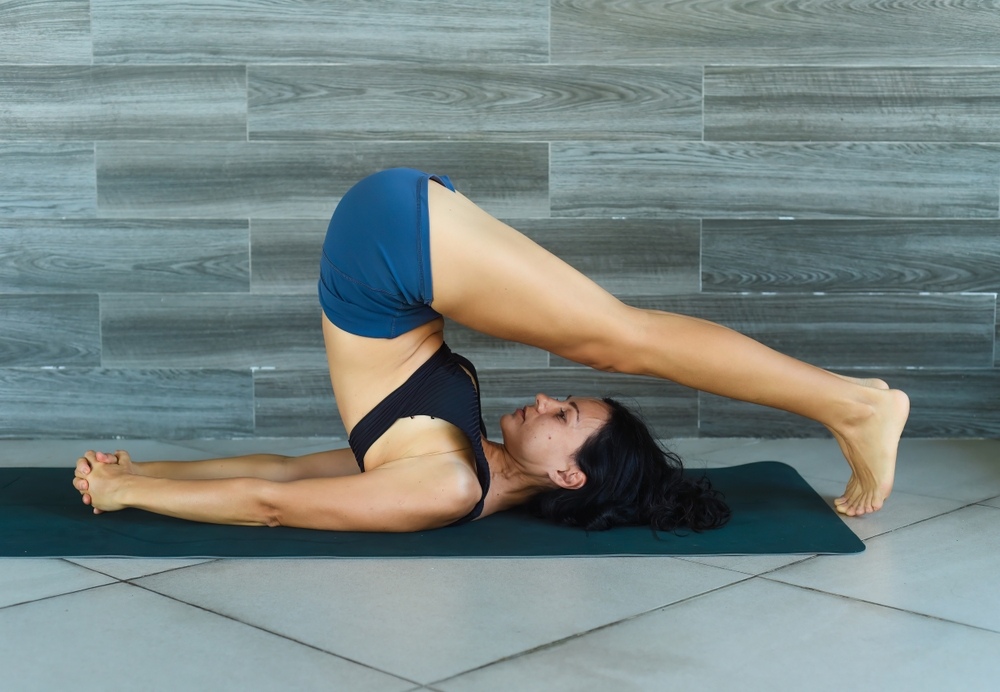
Halasana pose calms your mind as well as stretches and strengthens various parts of the body. Here, we will look deeper into the steps to perform the Plow Pose meticulously, ensuring maximum benefits.
Step-by-Step Guide to Performing Plow Pose
- Stack three blankets with aligned edges near the front of your mat.
- Sit at the front end of your mat and lie back over the blankets, adjusting so that the tops of your shoulders are an inch over the edge and your head rests on the floor.
- Bring your knees toward your chest and then straighten your legs toward the ceiling.
- Using your abdominal strength, lift your hips off the floor, supporting yourself with both hands at your lower or mid back.
- Slowly lower your legs backward over your head until your toes touch the ground behind you, keeping your feet flexed.
- Release your hands, placing your arms on the floor with palms down or hands clasped.
- Press down with your outer upper arms and shoulders to create a lift along the spine.
- Hold the pose for 5 breaths or more.
- To exit, unclasp your hands and press your arms and hands into the mat, slowly rolling down one vertebra at a time.
- Allow a few moments for your back to settle back into its normal curves.
After the Plough Pose is done, it is beneficial to engage in postures that help in realigning the spine and relaxing the body. Poses such as Savasana (Corpse Pose) can be effective as a follow-up that allows the body to find equilibrium after the intense stretch.
Tips for Practicing Plow Pose Perfectly
- Keep your gaze steady and your face lifted to the ceiling to ensure cervical safety.
- Maintain steady and slow breathing, even when the chest is compressed.
- Ensure your neck is aligned with your spine and that your weight is evenly distributed.
- Rest your weight on your upper shoulders, not on your neck and head.
- Avoid moving your neck from side to side while in the pose.
- Hands can be placed on the spine or hips based on comfort.
- Bend your knees slightly for ease and comfort.
- Ensure slight pressure on your chest by tucking your chin into your chest.
- Activate shoulder and arm muscles to prevent excessive pressure on the neck.
- Ensure proper spinal alignment by pressing toes into the floor or rounding the back as needed.
- Keep hands on the back for support if your toes don’t reach the floor.
10 Amazing Benefits of Plow Pose
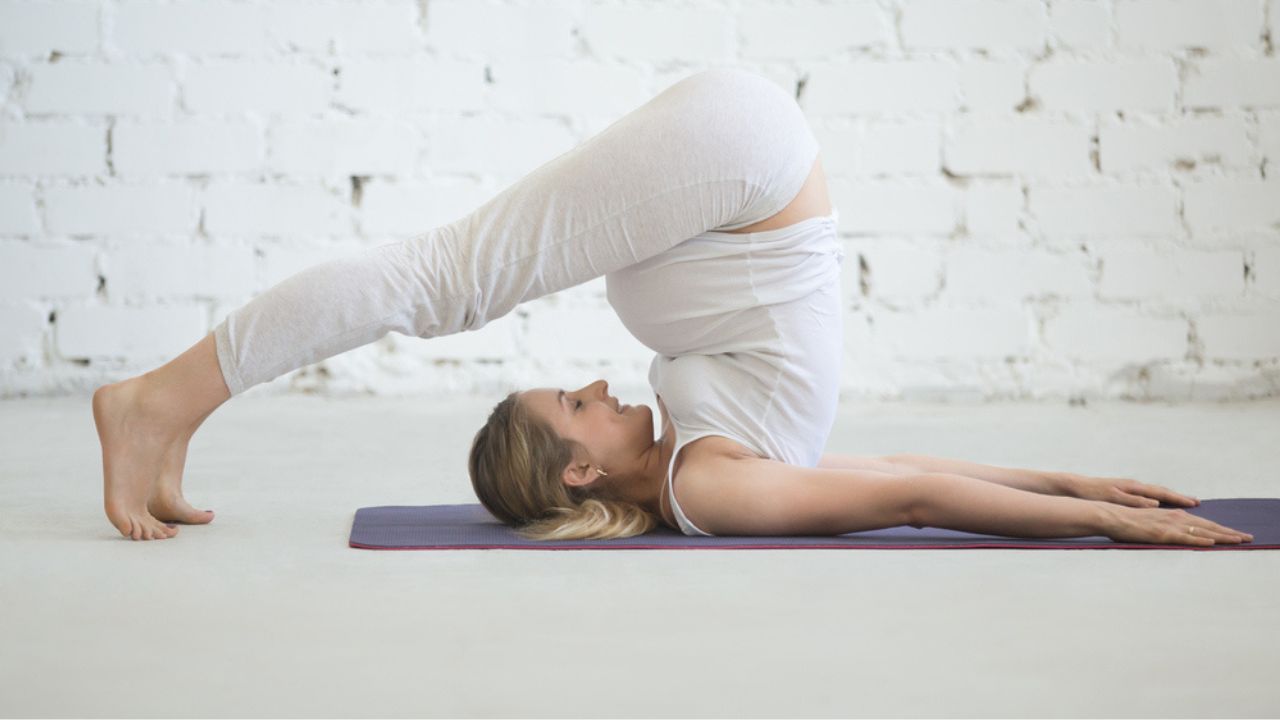
Plow Pose, or Halasana, stands out as an inverted pose with profound benefits. This intermediate-level asana not only strengthens and stretches the body but also calms the mind, contributing to overall well-being.
1. May Help in Controlling Blood Pressure
Halasana, being an inversion, allows better blood circulation throughout the body. This yoga posture can be particularly helpful in managing and improving blood pressure levels (1).
2. May Boost Flexibility and Joint Mobility
Halasana is known to enhance flexibility, making the muscles and joints more agile. The pose stretches the spine and tones the back muscles, contributing to better posture and reduced risk of injuries (2).
3. May Enhance Digestive Health
The Plow Pose stimulates the digestive system and can be a remedy for stomach disorders. By gently massaging the colon, it promotes proper digestion and absorption of nutrients (3).
4. May Alleviate Back Pain
The stretching and strengthening effect of Halasana on the back muscles can provide relief from backaches and improve spinal strength and flexibility (4).
5. May Work as a Stress Reliever
Halasana calms the nervous system and can be therapeutic for anxiety and stress. Practitioners often find mental barriers being lifted, promoting overall mental well-being (5).
6. May Aid in Diabetes Management
Halasana helps in stimulating the organs to regulate blood sugar levels, thereby aiding in diabetes management (6).
7. May Stimulate Thyroid Glands
By reversing the blood flow, Halasana ensures proper blood supply to the thyroid glands, potentially aiding in better hormonal regulation.
8. May Relieve Leg Cramps
The pose stretches leg muscles, providing relief from cramps and enhancing muscular flexibility (7).
9. May Strengthen the Immune System
With your "feet over head position", this pose ensures proper blood circulation to every nerve ending, fortifying the immune system (8).
10. May Promote Healthy Hair
By directing blood flow to the scalp, Halasana can potentially contribute to healthier hair.
Practicing plow position promotes both mental and physical well-being. By adhering to the guidelines and understanding the extensive benefits, practitioners can safely and effectively include Plow Pose into their routine.
Precautions to Consider While Performing Plow Pose
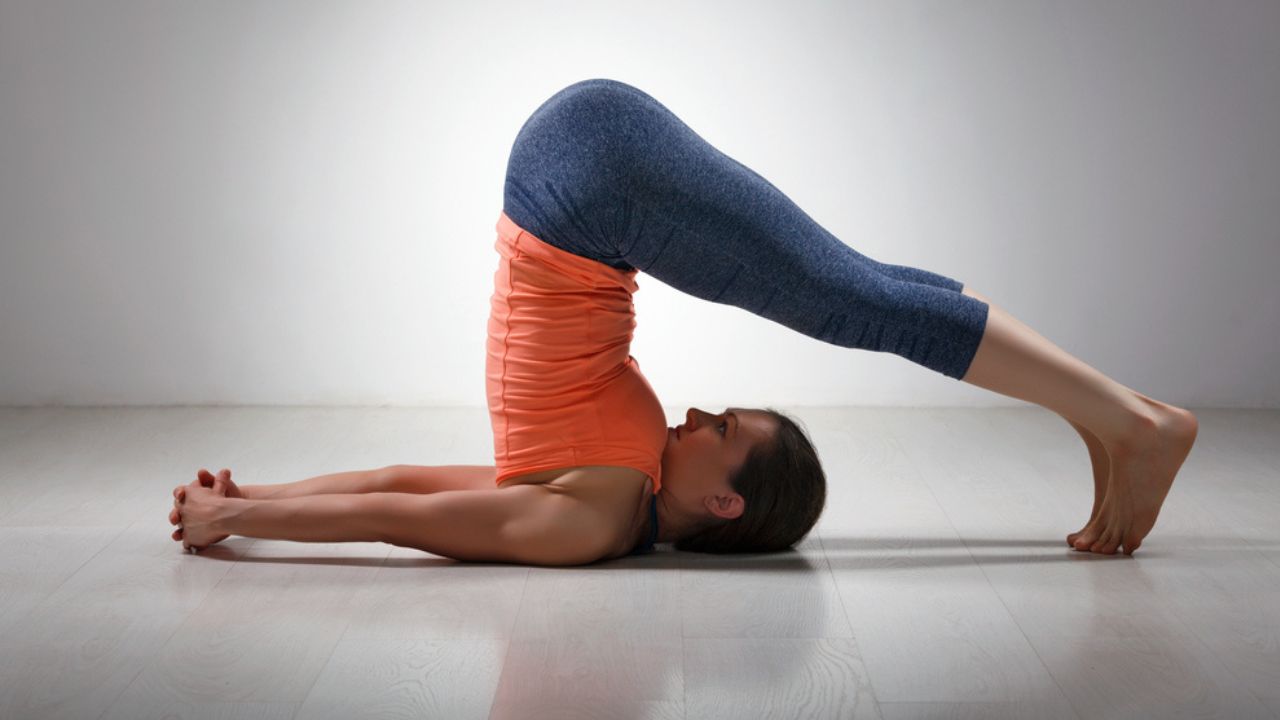
Plow Pose offers numerous benefits, yet it is vital to practice it with caution to avoid any strain or injury.
Here are some precautions to keep in mind while performing Halasana.
Safeguard Your Cervical Vertebrae: Keep your cervical vertebrae safe by using folded blankets or cushions to elevate the shoulders and protect the neck. Avoid putting excessive pressure on the neck.
Back and Neck Considerations: Individuals with pre-existing back or neck conditions should approach Halasana with caution. Practitioners experiencing back or neck pain should refrain from attempting this pose. Those with conditions like bulging or herniated discs should consult a healthcare professional before practicing.
Eye Conditions and Inversions: Individuals with glaucoma, detached retina, or diabetic retinopathy should seek advice from an ophthalmologist before attempting Halasana.
While Plow Pose can be a transformative addition to one's yoga practice, it is imperative to approach it with mindfulness and precaution. By being aware of one's body and respecting its boundaries, practitioners can ensure a safe and enriching experience with Halasana.
Plow Pose Variations And Modifications
Practicing Plow Pose, or Halasana, can sometimes be challenging due to lower back pain, tight hamstrings, or other physical restrictions. However, variations and modifications of this pose can make it accessible to everyone. Here, we explore three such modifications that ensure you can reap the benefits of Halasana without straining your body.
1. Half Plow Pose
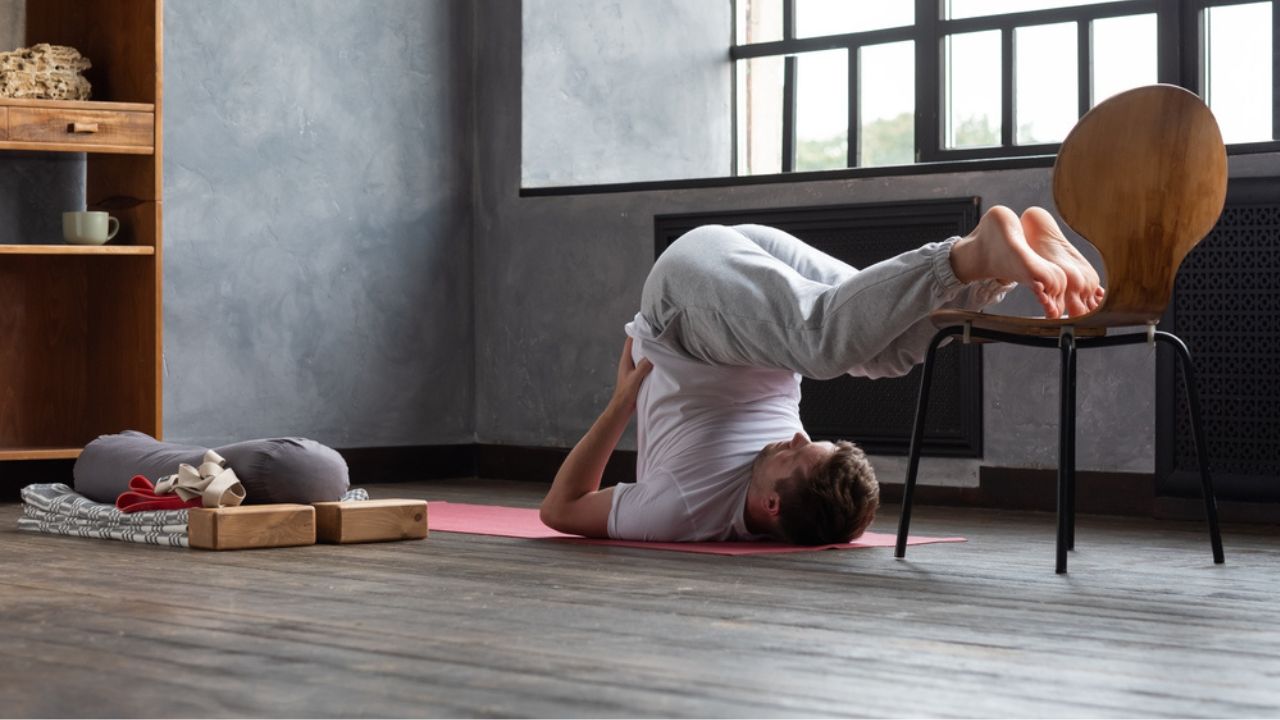
The Half Plow Pose is a subtle variation that reduces pressure on the neck and spine. It's a perfect alternative for those finding the full Plow Pose too intense.
Steps:
1. Lie down on your back with your legs extended and arms by your side.
2. Slowly lift your legs towards the ceiling, ensuring that your hips are not stacked over your shoulders.
3. Maintain a slight angle, keeping space between your chin and chest.
4. Hold for a few breaths, then gently lower your legs back down.
2. Plow Pose against a Wall/ chair
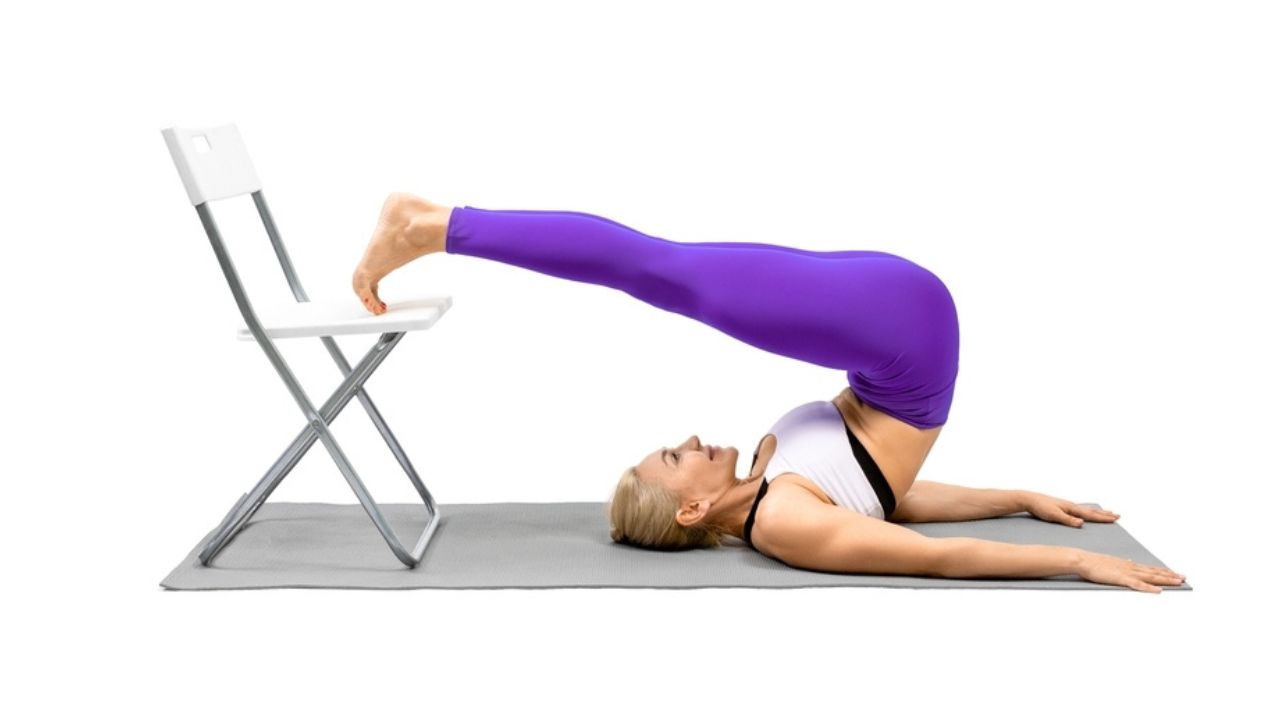
Practicing Plow Pose against a wall provides support and alleviates pressure, making it ideal for beginners or those with back concerns. The same process you can try with a chair instead of a wall.
Steps:
1. Lay 2 or 3 folded blankets near a wall and lie down facing away, positioning your head about 2 feet from the wall.
2. Elevate your legs into the Supported Shoulder stand (Salamba Sarvangasana) with your hands supporting your lower back.
3. Gradually lower your legs until your feet meet the wall, straightening your legs and extending your spine.
4. Hold the position for several breaths, then gently release and come down.
3. Legs up with a Block: Elevating with Ease
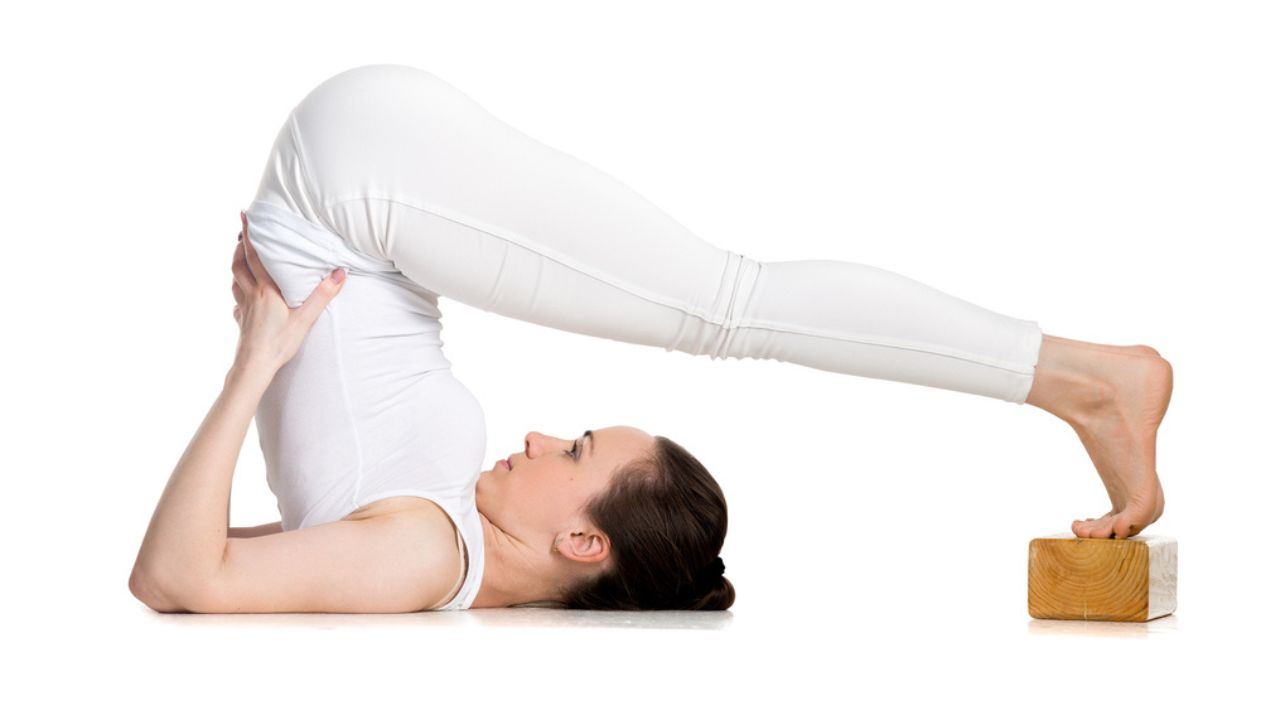
Using a block to elevate the legs in this modification eases tension in the lower back, making it a comfortable alternative to the traditional pose.
Steps:
1. Begin lying on your back with knees bent and feet flat.
2. Lift your hips and place a block under your sacrum on low or medium height.
3. Extend your legs upwards, aligning your ankles and knees over your hips.
4. Hold for as long as comfortable, then gently lower your legs, remove the block, and extend your legs on the floor.
These variations and modifications ensure that Halasana is adaptable and accessible, allowing practitioners of all levels to benefit from this rejuvenating inversion.
Conclusion
With your feet suspended above and hips elevated, Plow Pose introduces an unconventional yet beneficial, physical stance. Halasana, often sequenced towards the culmination of practice, ensures a smooth transition into the peaceful Savasana. By taking your legs over your head, it shifts your center of gravity, necessitating a mindful engagement of shoulders and arms.
Adding Halasana to your routine can be a game-changer. Whether practiced solo, in a sequence, or as an alternative to other inversions, Plow Pose yoga paves a path to holistic wellness. Always mindful of your body's needs and potential constraints, Halasana proves that yoga is a journey of self-discovery and fine-tuning.
Contributor: Bayu Prihandito, Certified Psychology Consultant, Life Coach, and RYT 200 Yoga Teacher, Founder - Lifearchitekture
ALSO READ: Bridge Pose: A Yoga Posture That Brings Body And Mind Wellness





 JOIN OUR WHATSAPP CHANNEL
JOIN OUR WHATSAPP CHANNEL
































































































